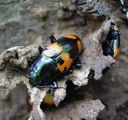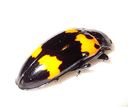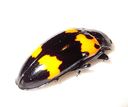Megalodacne
Megalodacne
Classification
- Phylum: Arthropoda
- Subphylum: Hexapoda
- Class: Insecta
- Order: Coleoptera
- Suborder: Polyphaga
- Superfamily: Cucujoidea
- Family: Erotylidae
- Subfamily: Erotylinae
- Tribe: Encaustini
- Genus: Megalodacne
Pronunciation
How to pronounce Megalodacne: //ˌmɛɡəloʊˈdækni//
These audio files are automatically generated. While they are not always 100% accurate, they are a good starting point.
Images






Summary
Megalodacne is a genus of large, colorful beetles known for their fungivorous diet and presence in wooded areas abundant with bracket fungi.
Physical Characteristics
Adults range in size from 9 to 22 millimeters (0.35 to 0.87 in), characterized by bright colors and patterns. Larvae are highly sclerotized and found in bracket fungi. Adults have large eyes and a characteristic structure of tarsomeres.
Identification Tips
Megalodacne fasciata can be confused with Megalodacne heros; the latter is larger and lacks the rows of fine punctures on the elytra that are characteristic of M. fasciata. Close inspection of scutellar macula and pronotal sides can aid in identification.
Habitat
Typically found in environments with bracket fungi, including woodlands and forests.
Distribution
Primarily Nearctic and parts of Asia, with species found in eastern North America, Japan, Korea, China, Southeast Asia, Tanzania, and parts of Africa.
Diet
Fungivorous, feeding on bracket fungi such as Ganoderma and Fomes species.
Life Cycle
Eggs are deposited on the fungi. Larvae feed by burrowing into the fungi or gnawing out shallow depressions. The larval stage lasts about 2 to 3 months before pupation.
Reproduction
Females deposit eggs on the fungi that serve as food for the larvae.
Ecosystem Role
Plays a role in decomposition by feeding on fungi.
Collecting Methods
- Hand collecting from known habitats, especially under bark or near fungi.
Preservation Methods
- Ethanol preservation
- Drying specimens for taxonomic study.
Evolution
Megalodacne was first described by George Robert Crotch in 1873 and is closely related to the genera Episcapha and Episcaphula.
Similar Taxa
- Episcapha
- Episcaphula
- Glischrochilus
Misconceptions
Often confused with smaller sap beetles due to similar coloration patterns.
Tags
- Coleoptera
- fungivorous
- Erotylidae
- Megalodacne